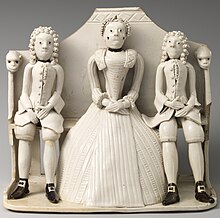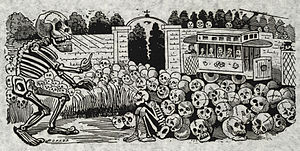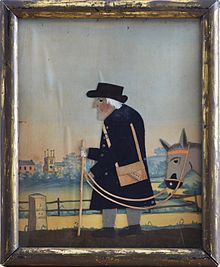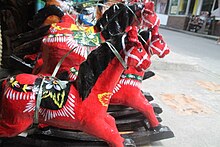Does the Folk Art Museum Still Have Free Music Fridays




Traditional styles of faience pottery from Székely Land, Romania, on sale in Budapest in 2014. A conventional idea of folk art, though no doubt made in quasi-industrial conditions.
Folk art covers all forms of visual art made in the context of folk culture. Definitions vary, merely generally the objects have applied utility of some kind, rather than being exclusively decorative. The makers of folk art are typically trained within a pop tradition, rather than in the art tradition of the culture. There is often overlap, or contested ground[1] with 'naive art'. "Folk art" is not used in regard to traditional societies where ethnographic art continue to be made.
The types of objects covered by the term "folk art" vary. The art grade is categorised as "divergent... of cultural production ... comprehended by its usage in Europe, where the term originated, and in the United states of america, where it developed for the most part along very different lines."[two]

For a European perspective, Edward Lucie-Smith described it as "Unsophisticated fine art, both fine and applied, which is supposedly rooted in the commonage sensation of simple people. The concept of folk art is a distinctly 19th-century i. Today it carries with it a tinge of nostalgia for pre-industrial social club."[iii]
Folk arts reflect the cultural life of a customs. The art form encompasses the expressive culture associated with the fields of folklore and cultural heritage. Tangible folk fine art can include objects which historically are crafted and used within a traditional community. Intangible folk arts can include such forms as music and art galleries , trip the light fantastic toe and narrative structures. Each of these fine art forms, both tangible and intangible, typically were adult to address a practical purpose. Once the purpose has been lost or forgotten, there ordinarily is no reason for further transmission unless the object or action has been imbued with meaning across its initial practicality. These artistic traditions are shaped past values and standards that are passed from generation to generation, nigh often within family and community, through demonstration, chat, and practice.
Characteristics of folk art objects [edit]

Detail of 17th century calendar stick carved with national coat of artillery, a mutual motif in Norwegian folk art.
Objects of folk art are a subset of material culture and include objects which are experienced through the senses, by seeing and touching. Typical for material culture in art, these tangible objects tin can exist handled, repeatedly re-experienced, and sometimes broken. They are considered works of art because of the technical execution of an existing course and design; the skill might exist seen in the precision of the form, the surface decoration or in the beauty of the finished product.[iv] Every bit a folk art, these objects share several characteristics that distinguish them from other artifacts of cloth civilization.
Folk artists [edit]
The object is created by a single artisan or squad of artisans. The craft-person works within an established cultural framework. The folk fine art has a recognizable style and method in crafting its pieces, which allows products to be recognized and attributed to a single individual or workshop. This was originally articulated by Alois Riegl in his study of Volkskunst, Hausfleiss, und Hausindustrie, published in 1894. "Riegl ... stressed that the individual mitt and intentions of the creative person were significant, even in folk creativity. To be sure, the artist may have been obliged by grouping expectations to work within the norms of transmitted forms and conventions, just individual creativity – which implied personal aesthetic choices and technical virtuosity – saved received or inherited traditions from stagnating and permitted them to be renewed in each generation."[v] Individual innovation in the product procedure plays an important role in the continuance of these traditional forms. Many folk art traditions like quilting, ornamental motion picture framing, and decoy etching go on to be skilful, and new forms go on to sally.
Contemporary outsider artists are frequently cocky-taught, and their work is usually adult in isolation or in small-scale communities across the state. The Smithsonian American Fine art Museum houses over 70 folk and self-taught artists.[6]
Hand crafted [edit]

Folk art objects are usually produced in a ane-off production process. Just i object is made at a time, either by hand or in a combination of manus and machine methods, and are not mass-produced. As a result of manual product, private pieces are considered to be unique and commonly can exist differentiated from other objects of the aforementioned type. In his essay on "Folk Objects", folklorist Simon Bronner references preindustrial modes of product, just folk fine art objects continue to be made every bit unique crafted pieces past folk artisans. "The notion of folk objects tends to emphasize the handmade over car manufactured. Folk objects imply a mode of production mutual to preindustrial communal society where knowledge and skills were personal and traditional."[7] Folk art does not need to be sometime; it continues to exist hand-crafted today in many regions around the world.
Workshops and apprentices [edit]
The design and production of folk art is learned and taught informally or formally; folk artists are non self-taught. [ citation needed ] Folk art does not aim for individualistic expression. Instead, "the concept of group art implies, indeed requires, that artists larn their abilities, both manual and intellectual, at to the lowest degree in function from communication with others. The community has something, normally a great deal, to say nigh what passes for acceptable folk art."[8] Historically, the grooming in a handicraft was washed as apprenticeships with local craftsmen, such as the blacksmith or the stonemason. As the equipment and tools needed were no longer readily available in the community, these traditional crafts moved into technical schools or practical arts schools.
[edit]
The object is recognizable inside its cultural framework as being of a known type. Similar objects can exist institute in the environment made by other individuals which resemble this object. Individual pieces of folk art will reference other works in the culture, even as they show exceptional individual execution in form or design. If antecedents cannot exist plant for this object, it might nonetheless be a slice of art just it is non folk fine art. "While traditional society does non erase ego, it does focus and direct the choices that an private can passably make… the well-socialized person will find the limits are non inhibiting but helpful… Where traditions are salubrious the works of different artists are more similar than they are unlike; they are more compatible than personal."[9] Tradition in folk art emerges through the passing of information from ane generation to some other. Through generations of family lines, family members pass down the noesis, data, skills and tools needed to continue the creation of ane's folk art. Examples are Leon "Peck" Clark, a Mississippi basket maker, who learned his skills from a community member; George Lopez of Cordova, New Mexico, who is a 6th-generation santos carver who's children likewise carve; and the Yorok-Karok basket weavers, who explain that relatives generally taught them to weave." [10]
Utility of the object [edit]
The known blazon of the object must be, or take originally been, utilitarian; information technology was created to serve some function in the daily life of the household or the community. This is the reason the design continues to be made. Since the grade itself had role and purpose, it was duplicated over time in various locations by different individuals. A book on the history of art states that "every man-made thing arises from a problem as a purposeful solution."[11] Written by George Kubler and published in 1962, "The Shape of Time: Remarks on the History of Things" describes an arroyo to historical modify which places the history of objects and images in a larger continuum of time. The purpose of folk art is not purely decorative or aimed to have duplicated handicraft. All the same, since the grade itself was a singled-out type with its function and purpose, folk fine art has continued to exist copied over time by different individuals.
Aesthetics of the genre [edit]
The object is recognized as existence exceptional in the course and decorative motifs. Existence part of the community, the craftsperson is reflecting on the community'due south cultural aesthetics, and may take into consideration the community's response to the handicraft. An object tin exist created to match the community's expectations, and the creative person may design the product with unspoken cultural biases to reflect this aim.[12] While the shared class indicates a shared culture, innovation tin can enable the individual artisan to embody their ain vision. This can be a representation of manipulating collective and individual culture, within the traditional folk art production. "For fine art to progress, its unity must be dismantled and so that certain of its aspects can be freed for exploration, while others shrink from attention."[13] This dichotomous representation of the civilisation is typically visible in the final production.[14]
Materials, forms, and crafts [edit]
Folk art is designed in different shapes, sizes and forms. Information technology traditionally uses the materials which are at manus in the locality and reproduces familiar shapes and forms. The Smithsonian Heart for Folklife and Cultural Heritage has compiled a page of storied objects that take been part of one of their almanac folklife festivals. The listing below includes a sampling of different materials, forms, and artisans involved in the production of everyday and folk art objects.[fifteen]
- Alebrije
- Armourer
- Basketry
- Bellmaker
- Blacksmith
- Boat building
- Brickmaker
- Broommaker
- Cabinetry
- Carpentry
- Ceramics
- Chillum
- Clockmaker
- Cooper
- Coppersmith
- Cutler
- Decoy carving
- Drystone Mason
- Ex-voto
- Farrier
- Foodways
- Fraktur
- Furniture
- Gunsmith
- Harness maker
- Ironwork
- Jewelry
- Kuthiyottam
- Latin American Retablos
- Leather crafting
- Lei (garland)
- Ljuskrona
- Locksmith
- Lubok
- Madhubani painting
- Masonry
- Metalworking
- Millwright
- Miniatures or Models
- Nakshi Kantha
- Needlework
- Origami
- Painting
- Pewterer
- Phad painting
- Quilting
- Recycled materials
- Ropemaker
- Saddler
- Sawsmith
- Sculpture
- Shoemaker
- Spooner
- Stonemason
- Tanner
- Textiles
- Thatcher
- Tile maker
- Tinker
- Tinsmith
- Truck fine art in South Asia
- Tools
- Toys
- Treenwaren
- Turning
- Vernacular architecture
- Wainwright
- Weaver
- Wheelwright
- Whirligig
- Wood carving
[edit]
Listed below are a broad-ranging assortment of labels for an eclectic grouping of art works. All of these genres are created outside of the institutional structures of the art world, and are not considered "fine art". There is overlap between these labeled collections, such that an object might exist listed under two or more labels.[2] Many of these groupings and individual objects might also resemble "folk art" in its aspects, however may not align to the defining characteristics outlined above.
- Americana
- Fine art brut
- Folk Environments
- Genre paintings
- Naïve art
- Outlier art[16]
- Outsider art
- Primitive art
- Tramp art
- Trench art
- Tribal art
- Vanguard fine art[16]
- Colloquial fine art
- Visionary art
Influence on mainstream art [edit]
Folk artworks, styles and motifs have inspired various artists. For example, Pablo Picasso was inspired by African tribal sculptures and masks. Natalia Goncharova and others were inspired past traditional Russian pop prints chosen luboks.[17]
In 1951, creative person, writer and curator Barbara Jones organised the exhibition Black Eyes and Lemonade at the Whitechapel Gallery in London as part of the Festival of Britain. This exhibition, forth with her publication The Unsophisticated Arts, exhibited folk and mass-produced consumer objects alongside contemporary art in an early instance of the popularisation of pop art in U.k..[18]
Supporting organizations [edit]
The United nations recognizes and supports cultural heritage around the globe,[xix] in particular UNESCO in partnership with the International Organization of Folk Fine art (IOV). Their declared mission is to "farther folk art, customs and civilization around the globe through the organization of festivals and other cultural events, … with emphasis on dancing, folk music, folk songs and folk fine art."[xx] Past supporting international exchanges of folk art groups as well as the organization of festivals and other cultural events, their goal is promote international understanding and world peace.
In the United States, the National Endowment for the Arts works to promote greater understanding and sustainability of cultural heritage across the United states of america and around the world through research, education, and community engagement. Every bit role of this, they identify and back up NEA folk art fellows in quilting, ironwork, woodcarving, pottery, embroidery, basketry, weaving, forth with other related traditional arts. The NEA guidelines ascertain as criteria for this award a display of "actuality, excellence, and significance inside a item tradition" for the artists selected. (NEA guidelines) ." In 1966, the NEA's first year of funding, support for national and regional folk festivals was identified as a priority with the beginning grant made in 1967 to the National Folk Festival Association. Folklife festivals are celebrated effectually the world to encourage and support the education and community engagement of various ethnic communities.
Regional folk arts [edit]
- African folk fine art
- Chinese folk art
- Mingei (Japanese folk art move)
- Minhwa (Korean folk fine art)
- Mak Yong (Northern Malay Peninsular folk fine art trip the light fantastic)
- Mexican handcrafts and folk art
- Joget (Wider Malay folk art dance)
- Northward Malabar
- Theyyam
- Tribal art
- Warli painting (Bharat)
- Folk arts of Karnataka (Republic of india)
- Folk Art and Ethnological Museum of Macedonia and Thrace
- Folk Fine art Museum of Patras, Greece
- Native American Art
- Folk fine art of the United States
Associations [edit]
- Folk Art Society of America
- IOV International Organization of Folk Fine art, in partnership with UNESCO
- National Endowment for the Arts
- CIOFF: International Council of Organizations of Folklore Festivals and Folk Arts
- Pennsylvania Folklore: Woven Together TV Program on textile arts
- National Folk Organization
Museum Collections [edit]
- American Folk Art Museum
- Smithsonian American Art Museum
- Folk Art Center and Guild, Asheville NC
- Museum of International Folk Fine art
- American Folk Art Museum
- Abby Aldrich Rockefeller Folk Art Museum
- Shelburne Museum
Citations [edit]
- ^ (Wertkin 2004, p. xxxiv-xxxvi)
- ^ a b (Wertkin 2004, p. xxxii)
- ^ Lucie-Smith, Edward, The Thames & Hudson Dictionary of Art Terms, p. 95, 2003 (2nd edn), Thames & Hudson, Earth of Art serial, ISBN 0500203652
- ^ (Wertkin 2004, p. thirty)
- ^ (Wertkin 2004, p. xxviii)
- ^ "Folk and Self-Taught Art". SAAM . Retrieved 11 June 2020.
- ^ (Bronner 1986, p. 214)
- ^ (Vlach 1992, p. 19)
- ^ (Vlach 1992, p. xx)
- ^ Congdon, Kristin (1986). "Finding the Tradition in Folk Art: An Fine art Educator's Perspective". The Periodical of Aesthetic Educational activity. xx (three): 95. JSTOR 3332437.
- ^ (Kubler 1962, p. 8)
- ^ (Toelken 1996, p. 221)
- ^ (Glassie 1992, p. 271)
- ^ (Pocius 1995, p. 421)
- ^ (Roberts 1972, p. 240 ff)
- ^ a b "Outliers and American Vanguard Art". National Gallery of Art . Retrieved eleven June 2020.
- ^ Goncharova Biography Archived 2009-07-20 at the Wayback Machine, Hatii, retrieved xix/2/2012
- ^ Moriarty, Catherine (2017-11-30). "Popular Fine art, Pop Art, and 'the Boys who Turn out the Fine Arts'". Pop art and blueprint. Massey, Anne, 1956-, Seago, Alex. London, Uk. pp. 25–47. ISBN9781474226189. OCLC 928487681.
- ^ "'Dandy MASTERS OF MEXICAN FOLK ART' Exhibit TO OPEN AT UN HEADQUARTERS ON 10 April | Meetings Coverage and Press Releases". world wide web.united nations.org . Retrieved 2019-04-08 .
- ^ UNESCO Mission Statement
See also [edit]
- Alebrije
- African folk fine art
- American Folk Art Museum
- Chester Cornett
- Chillum
- Chinese folk art
- Ex-voto
- Guy Cobb
- John William "Uncle Jack" Dey
- Juliana R. Force
- Kuthiyottam
- Latin American Retablos
- Ljuskrona
- Lubok
- Madhubani painting
- Mingei (Japanese folk art movement)
- Minhwa (Korean folk fine art)
- Museum folklore
- Naïve fine art
- Nakshi Kantha
- Olfactory organ art
- North Malabar
- Outsider fine art
- Phad painting
- Pakistani vehicle art
- Pasaquan
- Rebecca Couch
- Rural crafts
- Theyyam
- Thidambu Nritham
- Tribal art
- Vaillancourt Folk Art
- Warli painting
- Whirligig
- Yakshagana
- Czech folklore
References [edit]
- Bauman, Richard (1971). "Differential Identity and the Social Base of Folklore". The Journal of American Sociology. 84 (331): 31–41. doi:10.2307/539731. JSTOR 539731.
- Ben-Amos, Dan (1997a). "Performance". In Green, Thomas (ed.). Sociology An Encyclopedia of Beliefs, Customs, Tales, Music, and Art . Santa Barbara, CA: ABC-CLIO. pp. 630–35. ISBN9780874369861.
- Bronner, Simon J. (1986). "Folk Objects". In Oring, Elliott (ed.). Folk Groups And Folklore Genres: An Introduction . Logan, UT: Utah State University Press. pp. 199–223.
- Bronner, Simon J. (1986a). Grasping Things : Folk Material Civilization and Mass Order in America . Lexington: University Printing of Kentucky. ISBN9780813115726.
- Congdon, Kristin G. (1996). "Art, Folk". In Brunvand, Jan Harald (ed.). American Sociology, an Encyclopedia. New York, London: Garland Publishing. pp. 46–53.
- Glassie, Henry (1972). "Folk Art". In Dorson, Richard (ed.). Folklore and Folklife: an Introduction. Chicago: University of Chicago Printing. pp. 253–280. ISBN9780226158709.
- Dundes, Alan (1980). Interpreting Sociology. Bloomington and Indianapolis: Indiana University Press.
- Gabbert, Lisa (1999). "The "Text/Context" Controversy and the Emergence of Behavioral Approaches in Folklore" (PDF). Folklore Forum. 30 (112): 119–128.
- Glassie, Henry (1976). Folk Housing in Centre Virginia: Structural Analysis of Historic Artifacts. Univ of Tennessee Press. ISBN9780870491733.
- Glassie, Henry (1992). "The Thought of Folk Art". In Vlach, John Michael; Bronner, Simon (eds.). Folk Art and Art Worlds. Logan, Utah: Utah State University Press. pp. 269–274.
- Glassie, Henry (1999). Material Civilisation. Bloomington, IN: Indiana Academy Printing.
- Jones, Michael Owen (1975). The Handmade Object and its Maker. Berkeley, Los Angeles, London: Academy of California.
- Jones, Michael Owen (1997). "Fine art, Folk". In Green, Thomas (ed.). Sociology An Encyclopedia of Beliefs, Community, Tales, Music, and Art . Santa Barbara, CA: ABC-CLIO. pp. 56–sixty. ISBN9780874369861.
- Joyce, Rosemary (1992). ""Fame don't brand the Sun whatsoever cooler": Folk artists and the Market place". In Vlach, John Michael; Bronner, Simon (eds.). Folk Art and Art Worlds. Logan, Utah: Utah State University Press. pp. 225–241.
- Kubler, George (1980). "The Arts: Fine and Plain". In Quimby, Ian 1000.G.; Swank, Scott T. (eds.). Perspectives on American folk art . New York: Winterthur. pp. 234–246.
- Kubler, George (1962). The shape of time : Remarks on the History of Things . New Haven and London: Yale University Press.
- Pocius, Gerald L. (1995). "Art". The Journal of American Folklore. 108 (430): 413–431. doi:10.2307/541654. JSTOR 541654.
- Rahmen, Sabrina (2007). "INDUSTRIALIZING FOLK ART Aesthetic Transformation in Alois Riegl's Volkskunst, Hausfleiß und Hausindustrie (1894)" (PDF). Kakanien Revisited: Emergenzen.
- Riegl, Alois (1894). Volkskunst, Hausfleiss, und Hausindustrie. Berlin.
- Roberts, Warren (1972). "Folk Crafts". In Dorson, Richard (ed.). Sociology and Folklife: an Introduction. Chicago: University of Chicago Press. pp. 233–252. ISBN9780226158709.
- Santino, Jack (1992). "Tradition and Inventiveness in Halloween Folk Art". In Vlach, John Michael; Bronner, Simon (eds.). Folk Art and Art Worlds. Logan, Utah: Utah Land Academy Printing. pp. 151–169.
- Schenda, Rudolf (1970). Volk ohne Buch. Studien zur Sozialgeschichte der populaeren Lesestoffe 1770–1910. Frankfurt am Main 1970: Klostermann. ISBNiii-465-01836-ii.
{{cite book}}: CS1 maint: location (link) - Sims, Martha; Stephens, Martine (2005). Living Sociology: Introduction to the Study of People and their Traditions. Logan, UT: Utah State University Press.
- Teske, Robert (1986). "'Crafts Assist Programs' and Traditional Crafts" (PDF). New York Folklore. 12.
- Toelken, Barre (1996). The Dynamics of Sociology. Logan, UT: Utah Land University Press.
- Vlach, John Michael; Bronner, Simon (1992). "Introduction to the New Edition". In Vlach, John Michael; Bronner, Simon (eds.). Folk Art and Art Worlds. Logan, Utah: Utah State University Press. pp. xv–xxxi.
- Vlach, John Michael (1992). "Properly Speaking: The need for Plain Talk nearly Folk Art". In Vlach, John Michael; Bronner, Simon (eds.). Folk Fine art and Art Worlds. Logan, Utah: Utah State University Printing. pp. 13–26.
- Vlach, John Michael (1996). "Alphabetize of American Design". In Brunvand, Jan Harald (ed.). American Folklore, an Encyclopedia. New York, London: Garland Publishing. pp. 389–390.
- Vlach, John (1997). "Material Culture". In Dark-green, Thomas (ed.). Folklore An Encyclopedia of Behavior, Customs, Tales, Music, and Fine art . Santa Barbara, CA: ABC-CLIO. pp. 540–544. ISBN9780874369861.
- Wertkin, Gerard C. (2004). "Introduction". In Wertkin, Gerald C. (ed.). Encyclopedia of American Folk Art . New York, London: Routledge. pp. xxvii–xxxiii. ISBN9780415929868.
- Williams, Raymond (1985). Keywords: A Vocabulary of Culture and Society . USA: Oxford University Printing. ISBN978-0-19-520469-8.
- MM Hoque and SS Mostafizur Rahman, Wari-Bateshwer, Banglapedia: The National Encyclopedia of Bangladesh, Asiatic Society of Bangladesh, Dhaka, Retrieved; 11 Jan 2013
External links [edit]
| | Wikimedia Eatables has media related to Folk art. |
| | Wikiquote has quotations related to: Folk art |
- CIOFF: International Council of Organizations of Folklore Festivals and Folk Arts
- Pennsylvania Sociology: Woven Together TV Plan on textile arts
- Drove: "Folk, Self-Taught, Amateur, and Visionary Art" at the University of Michigan Museum of Art
Source: https://en.wikipedia.org/wiki/Folk_art
0 Response to "Does the Folk Art Museum Still Have Free Music Fridays"
Postar um comentário